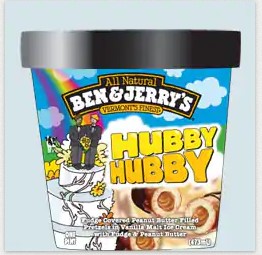In 2020, Ben and Jerry’s brand loyalty rose by 20%. That’s an impressive rise, especially in a year where most brands suffered. It’s especially impressive when you consider the number of premium ice cream competitors on the market.
Ben and Jerry’s is a different kind of company. Spend a minute or two looking at their website and social media handles and you’ll begin to see how they achieved that. They aren’t only focused on making the best ice cream. They’re focused on promoting progressive causes, making a positive impact on the world, and making crazy good ice cream.
The Ben & Jerry’s Brand also has a deep connection with their “fans” (they don’t call them customers). And it’s not the superficial kind. Ben and Jerry’s has cultivated the kind of intense loyalty that doesn’t waver—even when another premium brand of ice cream is on sale (say, Haagen Dazs).
So how do they do it? Let’s check it out.
Click to Jump
Ben & Jerry’s Blueprint for Building Customer Loyalty
1. State Your Values (and Stick to Them!)
Ben and Jerry’s ice cream is the top-ranked brand in the U.S. But you’d be hard pressed to find where that’s mentioned on their website (if it is at all). Again, that’s because making and selling the best ice cream isn’t their singular focus.
The company’s mission statement reflects their desire to be more than that. Everything they do is rooted in the concept of linked prosperity, the idea that people who achieve success should work to improve the world around them. And they’re committed to ensuring each aspect of their three-part mission (economic, product, and social mission) thrive equally—in a way that respects all people and the communities they’re part of.
When they talk about making the “best possible ice cream,” they don’t just mean the flavor. Ben & Jerry’s focuses on the processes and ingredients as well. It’s similar to how Starbucks aims for ethically sourced coffee and Ikea aims for sustainable production practices.

“Caring Dairy” reflects Ben and Jerry’s ethical practices for sourcing dairy. Their three-part mission aims to ensure the wellbeing of their dairy farm partners, farmworkers, cows, and the environment, while still getting the best dairy ingredients possible. This philosophy resonates deeply with consumers who value and care about responsible sourcing.
And more and more consumers are choosing only to do business with brands that share their values. In fact, a recent Nielsen study revealed that 73% of Millenials and 72% of GenZ are willing to pay more for goods made sustainably. These consumers would be loyal to a brand like Ben and Jerry’s—in fact, many are probably “fans” already.
2. Stay Customer Focused Even After You Make It Big
Ben and Jerry’s had humble beginnings. In 1978 with a $12,000 investment (and a 5-dollar course in ice cream making) Ben Cohen and Jerry Greenfield went into business together and opened their first ice cream shop in Burlington, VT. In less than 50 years, they reported $681 million in sales in 2019.
Many brands that achieve that kind of success bear little resemblance to their beginnings. Most brands don’t survive past 50 years.
That could have happened to Ben and Jerry’s after Unilever acquired them in 2000. Instead, Ben Cohen and Jerry Greenfield insisted on an independent board of directors as a condition of the sale. That ensured that the brand, mission, and ridiculously good ice cream didn’t change, and neither has their focus on the customer.
While the founders are no longer involved in day-to-day operations, the company has maintained the same customer focus, continuing yearly “free cone days” that began back when they celebrated their first anniversary in 1979.
Ben and Jerry’s continues to take fan feedback and suggestions seriously too. When 28,400 supporters signed a change.org petition asking Ben and Jerry’s to make vegan ice cream, the company listened. And more importantly, they took action and introduced a line of non-dairy and certified vegan flavors.

Ben and Jerry’s remains as connected to and focused on its customers as they have since Day 1. And they have earned the loyalty of their fans because of it.
Read about how TWIST Ice Cream parlor uses CandyBar for a loyalty program customers love!
3. Give Back to the Community and Causes
Every year Ben and Jerry’s donates 7.5% of pretax earnings to the Ben & Jerry’s Foundation. Established in 1985, the foundation continues to engage its employees in philanthropy and gives back to their communities through support of grassroots activism pushing for social and environmental justice.
Contrast that with the recent survey of 300 Fortune 500 businesses: their average charitable giving amounted to only 1% of pretax profits. Not too generous for multi-billion dollar companies.
But giving generously reflects one of Ben and Jerry’s core values: that successful companies should work to make the world a better place. And again, today’s consumers expect this of every brand they do business with. Ben and Jerry’s fans know their purchases of pints at the grocery store and visits to scoop shops support causes they believe in too. It’s what makes them even more loyal.
4. Be Authentic—Especially When You Advertise
As brands try to tap into values and advocacy, most of them get it wrong. Who can forget Pepsi’s poor attempt at cause-related marketing? There was a lot to criticize about the Kendall Jenner ad—from the tone, casting, and execution—no wonder it caused a backlash.
Contrast that with how Ben and Jerry’s wades into political and social issues with authenticity and authority. Here’s an ad they created to bring attention to the climate change crisis.
Whether it’s using solar to power a third of the electricity at their Vermont plant, installing a bio-digester at their European facility to make clean energy from manufacturing waste, or helping to pioneer technology for environmentally friendly freezer cases, Ben and Jerry’s has been committed to reducing its impact on the environment. Because of that, explaining climate change through the lens of melting ice cream doesn’t come across as contrived or inauthentic. It’s actually a perfect example of cause marketing.
Brands must advocate thoughtfully in today’s socially conscious environment. Ben and Jerry’s understands that, judging from their post about Black Lives Matter. Unlike Pepsi, they articulate their position with the seriousness it deserves, without product placement or any suggestion that their ice cream could alleviate social unrest.
A brand needs to know its customers on a very deep level to be authentic. Ben and Jerry’s ability to connect on a deeper level with their customers is one more reason they’ve been able to build such a loyal fan base.
5. Be Brave. Don’t Be Afraid to Put Your Money Where Your Mouth Is
Ben and Jerry’s have been vocal supporters of numerous progressive causes that a PR team would want to avoid for fear of alienating customers.
Other brands seem to purposely avoid anything that could be remotely controversial.
Michael Jordan famously said “Republicans buy sneakers too” when challenged about his lack of activism or political commentary during his career. If he were playing today his reluctance to voice an opinion wouldn’t fly. Today’s consumers expect brands to take a public stand on issues they care about—and some would say consumers are looking for an excuse to cancel brands.
That didn’t concern Ben and Jerry’s based on their early support of the LGBTQ community. They were the first major employer in Vermont to offer health insurance to domestic partners of employees. And when same-sex marriage was legalized in their state years later, they renamed one of their most popular flavors to Hubby Hubby to celebrate the change.

They took their advocacy overseas too. To protest Australia’s laws against same-sex marriage, they famously stopped selling two scoops of the same flavor in shops across the country until the law was reversed.
Their support of the LGBTQ community likely turned off some customers and led to lost profits. But for a values-driven company like Ben and Jerry’s—that believes marriage equality is a human rights issue—staying true to values comes before profits. It’s one more way they’ve earned the loyalty of their fans.
What’s Next For Ben and Jerry’s: “Doubling Its Social Impact”
Ben and Jerry’s has cultivated a kind of deep loyalty that transcends their product, a position most brands will never attain. One board member summed it up best when he described Ben & Jerry’s as “a social justice company, which just happens to make pretty good ice cream”.
New CEO Matthew McCarthy also challenged the company to “double its social impact” going forward. For many fans around the world, the Ben & Jerry’s brand means good ice cream—but also a connection with fans, closely held values, and commitment over a long time.
Now if you’ll excuse me, I’m off for some Ben & Jerry’s Chunky Monkey.


